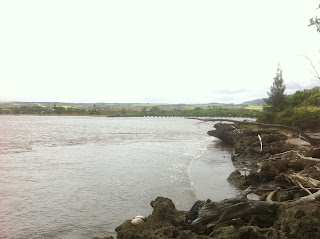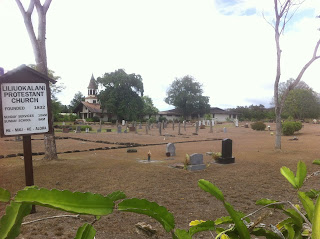Yesterday I took a drive to the north shore with my fiancé, her sister and nephew. I've been trying to research as much as I could on this district beforehand. Especially since my go to information guy, John Prime mentioned he was researching this area as well. This ones for you bud!
Waialua is a vast district with many sites to see. Nothing that can be done all at once, in one day
Waialua is supposed to be one of the earlier populated places on the island of Oahu. The royal families living up high in Helemano could actually hear the ocean from were they dwelled. The art of Lua and war was practiced in the so called Valley of Spears, Keawawaihe. Which leads to Schofield. Where war is still practiced today. The cannibal chief Aikanaka, said to have came from far lands in the pacific. Set up his base here for a short time. Until the population figured them out and disposed of them. A platter where he prepared his victims is said to have been hidden by Kamehameha youth. In order to hide that dark page in Oahu history. I like the story that he wasn't Hawaiian, and that's enough for me.
The land was and still is great for farming. Powerful ali'i and kahuna left their marks in history here long ago. Some from far away, bringing their own culture and secretly melding it with those already set before. Laniakea hints to southern Polynesian roots from Raiatea. As well as the location of Kapukapuakea and it's counter part in the Society islands Taputapuatea...
Up an old dirt road in Mokuleia headed toward Pu'u Kaupakuhale. Is a Catholic Monastery and some very private homes now. But in the past there were a couple of heiau and also some caves. That were mentioned by McAllister and Thrum.
The road becomes paved near the mouth of Makaleha Valley and leads all of the way up to the last house. Where a gate will stop any further entry by vehicle. Once we entered the church property two loose guard dogs came rushing toward our car and caused quite a stir. I spotted one person outside but no one approached our vehicle or came to see what the dogs were all worked up for. I have seen black and white images of the heiau in a book titled Pana Oahu and read that the church placed a water tower at the base and even partly on a section of the heiau. So I knew exactly where to look...
This image and the one below are the best shots I could get of the stone walls of Kalakiki Heiau under the trees. I was still inside of the car and quite flustered by the barking dogs. Hopefully I can return once day invited and take a walk around.
Kalakiki Heiau has a connection with the shark god of Waialua, Kalakiki. Which was represented in a large pohaku counterpart directly out in the ocean. Which was said to emit phosphorescent lights! Homes built near these places of worship were supposed to restrain from having doors facing the hills. Or sickness and death would enter.
Onehana Heiau is also associated with this area but was not found when McAllister did his survey. Both however have accounts of human sacrifice at them and McAllisters diagram of the heiau list two pits on it's northen corner large enough to fit a person...
Pu'uiki Cemetery is the final resting place of many Waialua Plantation workers. The people that helped open the gateway of travel from Honolulu to Waialua by rail.
Looking across Kaiaka Bay from the western side.
Here or nearby this area in Kaiaka Park, on the eastern side side of Kaiaka Bay in Paalaa Kai. Was a famous heiau named Kapukapuakea. Ma'ilikukahi was said to have been taken here by the kahuna of his time and made high chief of the entire island. Like a coronation ceremony of old.
Kapukapuakea Heiau was said to be linked to Kuiliola Heiau on Kaneilio Point in Waianae and Suggesting the use of sea navigation as well as southern Pacific roots. As Taputapuatea, it's counterpart in the society islands and Kuiliola was said to have been founded by a traveler from Kahiki...
Kapukapuakea Heiau was constructed of mostly wood. Although the beach is full of drift wood nowadays, it was Kauila wood that was used for the heiau.
Pohaku Lanai situated in the center of Kaiaka Park. It is said to have been used as a lookout point for schools of fish in the ocean. Once spotted, the watchman would beat the stone with a wooden pole and echo the signal to bring the nets. Legends would have it that Pohaku Lanai floated there from Tahiti. But reason would have one imagine that this was once where the sea level was at ages ago. That slowly carved out this curious limestone formation.
We stopped for lunch at Haleiwa (which would end up cutting my journey short later, because when people eat. They like go home already) and I entertained my soon to be nephew in-law by helping him up this preserved Pohaku at Storto's and letting him jump off of it into my arms. Many, Many times over. This was the rock that Storto's mentioned they could not move during their remodeling of the porch area...
Between the Haleiwa court house and Storto's is this large pohaku and another smaller one that looks like a shark fin. The former must have been placed here within the last few years because although I have noticed the large one. I'm sure I would remember that one. Last time I saw it on top of the other.
" Puupilo Heiau seaward of Haleiwa Courthouse, Paaloa. A slight elevation of land with an old coconut palm on the side is all that remains of this heiau."
-McAllister Arch. of Oahu
Kepuwai Heiau was once located here. Beside the church. It's stone used in the church construction. An all to familiar story in history as religions shift but keep important sites into their own.
Loko Ea pond once contained makaha gates to the ocean. Although it was a fresh water pond.
Here at Puaena Point. Elani was the father of the last Ali'i Aimoku of Oahu, Kahahana. His body was left to decay out in the open by order of Kahekili II. Like Ma'ilikukahi, Kahahana was the only other Ali'i to be voted as ruler of the island by other chiefs. After his battles with many famous warriors on both sides against Kahekili II. Kahahana lost and hid for almost two years in the mountains with his wife. Before he was finally found and executed near Moanalua's Pu'u kapu. His wife escaped to Kauai possibly with his body. Elani however became a part of the Waipio Rebellion. A last ditch effort to regain Oahu from it's Maui based rulers. By killing Kahekili II. The rebellion was foiled and the anger of Kahekili II was great. Which caused the death of most of the population of Oahu. Man, woman, and child were slaughtered. The bodies of the conspirators were placed out in the open. To remind the population of what would happen if anyone refused the right of the Maui rule over Oahu. Some say at the House of Bones,
Elani's body decomposed to the sad disgust of the people that lived nearby. Kahakakeu Kanaka was the name given to the area, land where the man was placed. Maeaea Kupaoa was the name of the shores across Waialua Bay at Haleiwa beach, meaning overwhelming smell...

















I work security at harbor...everything you wrote I didnt know, I love what you do,awesome research bro....i am a permanent follower....
ReplyDelete